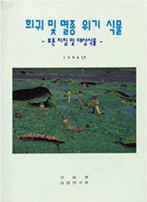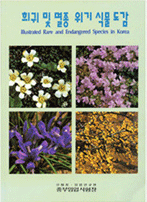- 글로벌메뉴
- KOREAN

 Korea Biodiversity Information System > Plant Resource > Plant Classification > Protected Plants > Rare Plants
Korea Biodiversity Information System > Plant Resource > Plant Classification > Protected Plants > Rare Plants
In general, the term rare plants is used to indicate wild plants that need to be conserved, especially those with an extremely small or decreasing population. The scope of rarity is determined by considering its geographical distribution area, the specificity degree of its habitat, and the size of its local population. Rare plants are referred to using various terms including endangered plants, protected plants, declining plants, endemic plants, plants protected by law, and Red List plants. Although the Korea Forest Service has commonly used "Rare and Endangered Species" while conducting preservation projects relating to rare plants, it uses the term "rare plant" in order to avoid confusion with the term "endangered species" after the specification of endangered species in the Natural Environment Conservation Act (Ministry of Environment, 2004).
The International Union for Conservation of Nature (IUCN) in 2002 identified that about 13% of the Earth's plants were endangered, and Groombridge (1992) reported that 584 species of angiosperms have become extinct since the1600s (over about 400 years).
The IUCN suggests the following evaluation categories for rare plants: Extinct in the Wild (EW), Critically Endangered (CR), Endangered (EN), Vulnerable (VU), Least Concern (LC) and Data Deficient (DD). The Red List recommended by IUCN is the most stable inventory as an evaluation standard for rare and endangered plants and is used as a standard program by most nations.
The Korean National Arboretum selected candidate species of rare plants by integrating many factors, such as plant literature, sample data, research data (southern or northern limit region), and climatic data, selected candidates and established the "Korean Red Data Book" (2009) by reevaluating them according to the Ramas Red List Version 2.0 (2001) recommended by the IUCN.
Refers to species considered to have already become extinct, including for rearing and cultivation, in spite of certification of past distribution in Korea.
Refers to species that had a history of distribution in Korea and exist as species for rearing or cultivating, but are considered to be extinct in the wild in Korea. In Korea, there are four taxa in this category, including , Scleria mutoensis, Aldrovanda vesiculosa, and Asplenium antiquum.
Critically Endangered plants are those at extremely high risk of extinction in their natural habitat in the near future. Among these, 144 taxa were selected, including Nymphaea minima, Paeonia japonica, Cypripedium japonicum, Aster altaicus Willd. var. uchiyamai, Berchemia racemosa, Habenaria radiata, Isoetes japonica, Halenia corniculata, Mankyua chejuense, Kirengeshoma koreana, Iris dichotoma, Aerides japonicum, Bupleurum latissimum, Neofinetia falcata, Abeliophyllum distichum, Cremastra unguiculata, Vexillabium yakushimense, Cypripedium macranthum, Dendrobium moniliforme, and Loranthus yadoriki.
Endangered plants are those not at urgent, but high risk of extinction in their natural habitat in the near future, and comprise 122 taxa, including Lycoris chejuensis, Lycoris chinensis, Drosera peltata, Aruncus aethusifolius, Trientalis europaea, Iris uniflora, Arisaema takesimense, Psilotum nudum, Tofieldia coccinea, Androsace cortusaefolia, Daphne kamtschtica, Primula modesta, Echinosophora koreensis, Calanthe reflexa, Paliurus ramosissimus, Trifolium lupinaster, Crinum asiaticum, Lecanorchis japonica, Hololeion maximowiczii, Pterygocalyx volubilis, Deutzia paniculata, Albizia kalkora Prain, and Lycoris koreana.
Vulnerable plants are those not critically endangered or endangered species, but will be at high risk of extinction in their natural habitat in the near future, and comprise 119 taxa, including Euryale ferox, Acanthopanax senticosus, Lonicera coerulea var. edulis, Koelreuteria paniculata Laxm, Cacalia pseudo-taimingasa, Ranunculus kazusensis, Calanthe discolor, Paeonia japonica, Drosera rotundifolia L. , Rhododendron micranthum, Bupleurum euphorbioides, Prenanthes ochroleuca, Gastrodia elata, Taxus cuspidata, Sparganium stoloniferum, Lysimachia pentapetala Bunge, Iris odaesanensis, Utricularia japonica, Milletia japonica, and Ligularia taquetii.
Plants that have low risk of extinction at this time, but contain factors that might move them to an endangered state according to changes in distribution conditions. These make up 70 taxa, including Nuphar japonicum, Asarum maculatum Nakai, Crypsinus hastatus, Gentiana triflora, Abies koreana, Disporum ovale, Viola diamantica, Penthorum chinense, Iris ensata var. spontanea, Fagus crenata var. multinervis, Botrychium virginianum, Rhododendron brachycarpum, Allium senescens, Ottelia alismoides, Phacelurus lalifolius, Tricyrtis dilatata, Campanula takesimana, Thuja orientalis, Anemone koraiensis, and Corylopsis gotoana var. coreana.
Plants that can easily be transferred to the category of endangered species by an alteration of environmental conditions, but not enough data, such as on distribution, can be obtained to make an assessment of their rank. These comprise 112 taxa, including Lloydia serotina, Rubus longisepalus var. tozawai, Rumex longifolius, Athyrium deltoidofrons, Miscanthus chejuensis, Sparganium japonicum, Asplenium normale, Euphorbia sieboldiana, Celtis edulis, Lespedeza angustifolioides, Carex paxii, Spiraea chartacea, Adenophora grandiflora, Lycopodium cernuum L, Thalictrum baicalense, Cirsium lineare, Veronica pusanensis Y. Lee, Arisaema negishii, Euonymus chibai, and Scrophularia koraiensis.

During the rare plant preservation project, the first problem faced was the priority of preservation. Many scholars and organizations have announced which plants are rare in their own ways. Because the relatively subjective opinions of only some scholars were reflected, it seemed improper to perform national projects for plant lists. Thus preparations were started for a list of plants to be preserved on an objective basis. In order to select the plants to be preserved in a long-term plan, they and their preservation priority should be decided on to establish preservation measures by first establishing an evaluation standard system for rare plants and then applying data accumulated from local sites for a certain period of time to it. About 900 species of traditionally known rare and endangered plants were substituted and their scores were aggregated to decide on a national rare plant list. In order to complement deficient data, a questionnaire asking about the rarity of the above-mentioned rare and endangered plants and recognition of them by 40 plant taxonomists and botanical experts was prepared and analyzed for scoring the results. As a result, reflecting the scoring of the rare plant list, it was decided to list a total of 217 taxa and 42 taxa of candidate species.
